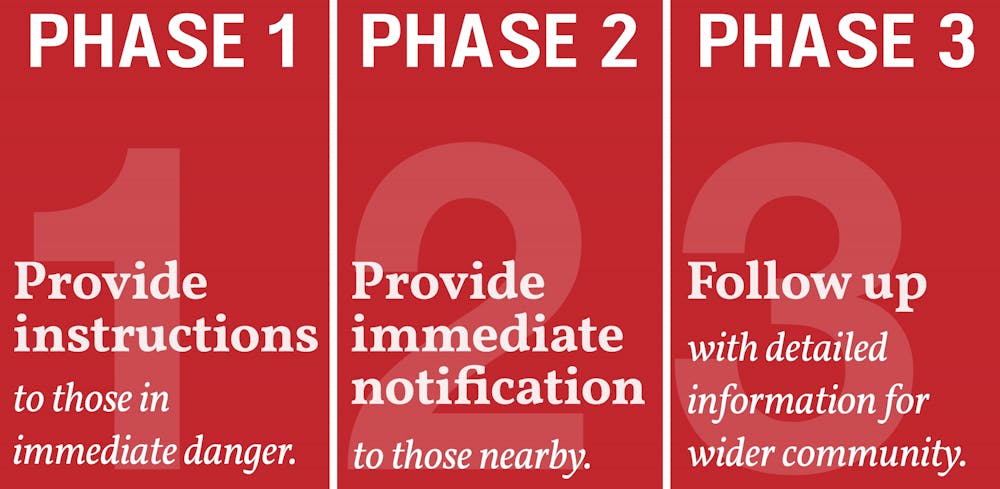After Bowling Green State University police took a suspect into custody for carrying a firearm on campus, it raised questions about Miami University’s plans to handle a similar situation.
John McCandless, chief of police at Miami, explained while there are a few exceptions for employees to carry a firearm under Ohio law, no guns are allowed on campus.
If this rule were to be broken, both the Miami University Police Department (MUPD) and Oxford Police Department (OPD) would respond.
Jessica Greene, assistant city manager for the City of Oxford, explained how MUPD and OPD would collaborate in an active shooter situation.
“When you talk about officers quickly locating and neutralizing the threat, whichever officers are closest are going to be the ones who actively do that,” Greene said.
McCandless and Greene said the two different departments train together for various reasons, including active shooter threats. Both departments have the means to notify students and the public.
The City of Oxford alerts its citizens to threats through a system called Nixle as well as through its social media.
“You can sign up with Nixle for anything from crime alerts to weather alerts,” Greene said. “Then they send out a message that shows up on your email and text messaging.”
Miami, on the other hand, uses the Emergency Notification Process, which includes notifying the community through email, Omnilert and blue tower loudspeakers.
Jessica Rivinius, director of university news & media relations, said the university has a three-step process to respond to active shooters on campus.
“The first phase is intended to provide immediate instructions to those who are in imminent danger,” Rivinius said. “The second phase is immediate notification. [It] is intended to provide initial notification to those who are not in imminent danger but may be nearby. The third phase is follow up. [It] is intended to provide the community with more detailed information ... and appropriate follow up measures.”
The specific instructions given to students and the public would vary based on the situation at hand.
Enjoy what you're reading?
Signup for our newsletter
“It would depend on where they were and where the active shooter situation was. It might be to avoid the area, it might be to shelter-in-place,” McCandless said.
In order to be prepared and feel safe, McCandless said students should watch the “RUN HIDE FIGHT Surviving an Active Shooter Event” video on the university's website. This video was put together by the City of Houston’s Mayor’s Office and Homeland Security.
“[The video] is pretty cutting edge,” McCandless said. “It gives people a pretty good sense of the things that law enforcement suggest people do in the case of an active shooter.”
This video reenacts what an active shooter situation can look like and provides a simple plan to remember: run, hide, fight.
If such an event does occur, multiple steps will be taken afterward to ensure the well-being for those individuals impacted.
“Miami University will provide counseling services to members of the campus community,” Rivinius said. “We would look for ways to have them visit and be available to those communities specifically affected by the event.”
In the 15 years that McCandless has worked as Chief of Police at Miami, there has not been an active shooter threat.
Overall, students interviewed feel safe on Miami’s campus.
Chloe Price, a senior majoring in political science, described how Miami’s location fosters safety.
“I transferred from the University of Toledo where it was very urban and an unsafe environment,” Price said. “I am from a really small rural area just like Oxford, and I basically feel just as safe here as I do at home.”
Lucy McCarthy, a first-year psychology major, said she has a slight concern about gun safety and thinks the university can do more from a communication standpoint.
“Overall safety here, sometimes, does not have as much information about when something is happening in our community,” McCarthy said.
McCarthy said these concerns arose after a recent Uptown incident.
However, Greene said there was never an active shooting threat.
“An employee at a local bar was trying to escort someone out,” Greene said. “When they were being asked to leave, a gun fell out of his waist belt. But the police were there, they arrested him, the gun was picked up and it was put in custody.”
While the threat of an active shooter has been historically low, students should be aware and know what to do in the event an active shooter situation does occur.
“Every school, college and K-12 institutions should have more training and be aware,” Price said. “It could happen anywhere.”




